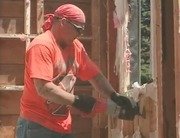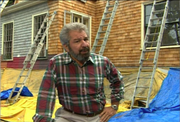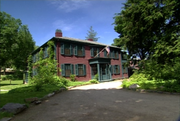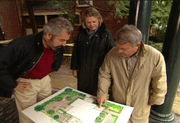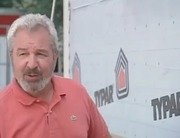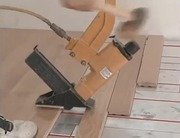We are in Kohler Wisconsin, visiting the Kohler company.
One of the major manufacuters of plumbing products, and who better to tell us all about it than the great grand daughter of the founder Laura Kohler.
Hi.
Welcome back.
Thank you, how are you?
Good, thank you.
It is great that we can start the tour not in the factory, but here in your showroom, because, this is a pretty unique facility, right.
We think that, it's a ten year old design center.
We created it so customer's could get actually get an idea of how to use to our product.
And it's become a tourist attraction as well.
Oh, yeah.
Over a 100,000 people a year visit the design center.
Its a little bit like going to a museum of modern art to look at not just plumbing fixtures, but the architecture here is pretty neat.
Yeah, well it's down in the water, is moving.
Exactly.
And vital workable product and , had fun.
Exactly that.
Lots of us who are in the building business and remodeling, are familiar with many of these products like these wonderful teal fixtures.
Whirl pools.
Right.
The whirl pools and the pedestal sinks and the like.
But you guys are constantly bringing out new things.
What are some of the new products?
Well, we've got the 10 jet body spa, which is actually, in simple.
In terms of standing whirlpool which has the 37 gallons of water and we circulate that water at 80 gallons of water for a minute.
So it's quite a huge force coming at you.
Yeah, that sounds like it.
But you can regulate it, so you can get the massage that you really want.
And there is also a new whirlpools, that just a traditional ones, right?
We've got a luxurious whirlpool that actually has back chest and a neck pillow with jets coming through so massage is going to act.
What's that called?
The Vigora.
The Vigora.
And then we have got vessels which are actually above corner lapse, they sit, they actually sit on the corner of your back .
So this is really leading edge contemporary design as well, but what I've always enjoyed about some other colonizes the kind of reproduction pieces that replicates some of the early plumbing features back we using some of them in our house.
We got a number of traditional suite the portraits, the vintage and the revival.
Well this is a lot like visiting a design display, but what we really want to do is learn a little bit about how the Vitreous China is manufactured.
Let's go over to our pottery, we've got Ken Werthover there.
And he's the manager of new product design and he can show you.
Great.
Ken tell us where the raw material comes from.
Raw materials come in box cars from North Carolina and Illinois and slurry comes in tank cars from Tennessee and Georgia.
And it's all stored out in powder form out there in silos, right?
Right.
The powdered form is in the 3 silos, you see up front.
And then here you've got the actual mixing operation.
Right.
Mike how is it going?
How does the batch look?
It's really smooth right now, it was a little lumpy five minutes ago , working real well now.
How long does it take a batch like this ready to go?
Well, fifty five minutes.
We get it all on target normally in fifty five minutes.
And do you have have to worry about lumps or impurities in there.
What we do upon completion in fifty five minutes Cycle, we will run all the finished slip over a screening device which is the eighty five mesh screen, and that will remove all the impurities.
Part of those impurities are lignite as well as iron, and here we've got magnetic filters that we use to.
These things here, these pipes and valves and things are actually magnets?
Right, those are magnets which will pull out the metal content that remains in there.
Is there much to deal with?
Well there's enough that it'll cause a defect in the final process and the defects in the final process just down grade the quality of your product.
Yeah, and Kollar does not make seconds, anything that has a defect gets broken up, right?
That's right.
The slurry he then goes is pipe from here to where they put it in the actual molds?
From here we pump our slurry into the storage tank, and the storage tank is a holding area for approximately 24 to 48 hours from there we pump it into our vinyl casting distribution.
So tell us whats happening in the cast shop.
Cast shop we will get the slip down through the respective distribution line.
The caster will fill the mold, either through a top funnel or he will use the pin to fill from the bottom.
And these gentlemen are working at a very fast pace here.
Right and because of the pace that these people work at, this is directly tied into the compensation that they can earn on a daily basis.
This is a very good work force that we have in this community.
That's great.
And then, once the slurry is put in the mold is up stay in the mode, how long do they stay in the mold?
Normal time is about 60 minutes for the process, and then we'll drain out the excess slip and about 15, 20, minutes or a half hour after that in draining process they will remove the top core.
This is a pretty vast space, now what do you call this area?
This is the cast shop area.
The cast shop, and what are these men doing?
They're rolling off the green piece.
At this point they're removing the top core.
And they will be getting ready to punch the faucet holes and over flow hole.
So there you got a lavatory.
Here we got a lavatory that started as a liquid this AM and now is a finished product here.
And from--from here well obviously they are cutting in the holes while it's still soft, but what happens next to it?
It goes through the drying process and then to the glaze depart or spray department, where glaze is applied, then we place it and kill for final vitrification.
Vitrification meaning actually turning into a glass like material.
Right.
Okay at this point, all of this is basically finished toilets or lavatorys or what ever right?
Yes.
And what happens here?
This is the quality control inspection area where he will use the ball to sound the piece.
That sound just tells us that there's a defect in product because it was not a crisp sound.
Can we compare the two?
That one is good?
Yes.
That one is duller.
Okay.
So, what happens to that one?
That?
We pack that product with, we will call scrap.
Okay.
Well what happens next to the ones that are good?
All the good pieces now will be past on to the water station where they check for leaks.
And at that particular point they will move to the grinding area for one hundred percent grinding it with foot as i explained.
Ready to go out to the packing station and then to the customer.
So the last step is to make sure its flat so that when we seat it on a ceramic tile floor it doesn't wobble.
That's right.
Thanks for the tour.
Thanks a lot.
Stick around, we'll be right back after these messages.

